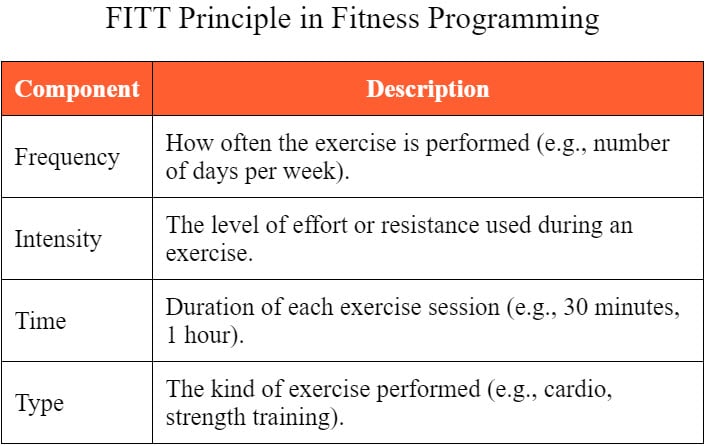how does the fitt principle apply to the development of a successful personal fitness program: The FITT Principle guides the design of a personal fitness program by addressing Frequency, Intensity, Time, and Type. It helps tailor workouts to individual goals and needs.
Creating a successful personal fitness program involves strategic planning and understanding key elements. The FITT Principle—Frequency, Intensity, Time, and Type—provides a framework for structuring workouts. Frequency determines how often you exercise, while Intensity measures the effort level. Time specifies the duration of each session, and Type refers to the kind of exercise performed.
By adjusting these variables, you can create a balanced and effective fitness plan. This approach ensures variety, reduces the risk of injury, and promotes consistent progress. Adopting the FITT Principle can help achieve long-term fitness goals efficiently.
Introduction To The Fitt Principle
The FITT Principle is a set of guidelines that help create effective fitness programs. It stands for Frequency, Intensity, Time, and Type. These elements are crucial for building a successful personal fitness plan. Understanding the FITT Principle can make your workouts more efficient and enjoyable.
Origin Of Fitt
The FITT Principle originated from exercise science. Experts developed it to provide a structured approach to physical activity. The goal was to help individuals achieve better fitness results. It ensures that every workout is balanced and comprehensive.
Here is a quick breakdown of each component:
- Frequency: How often you exercise.
- Intensity: How hard you work during exercise.
- Time: How long each exercise session lasts.
- Type: The kind of exercise you do.
Fitt’s Role In Fitness
The FITT Principle plays a vital role in fitness. It helps in setting clear and achievable goals. By following FITT, you can tailor your workouts to meet your specific needs. It also helps prevent overtraining and injury.
Here is how each component helps:
- Frequency: Regular workouts improve overall fitness.
- Intensity: Varying intensity levels boost performance.
- Time: Appropriate workout duration ensures effectiveness.
- Type: Diverse exercises keep workouts interesting.
By integrating the FITT Principle, you can enjoy a well-rounded fitness regimen. It ensures that you work on all aspects of fitness, from strength to endurance.
Frequency: Starting Your Fitness Journey
Starting a fitness journey is exciting. Frequency is the first step in the FITT principle. It means how often you work out. Setting the right frequency helps in building a habit. It also avoids burnout and injuries.
Determining Workout Frequency
Determining your workout frequency is crucial. Beginners should start slow. Here is a simple table to help you decide:
| Level | Workouts per Week |
|---|---|
| Beginner | 2-3 times |
| Intermediate | 3-4 times |
| Advanced | 4-5 times |
Listen to your body. Don’t push too hard at first. Consistency is more important than intensity.
Adapting Frequency Over Time
As you get stronger, you can adapt your frequency. Increase workouts gradually. Here are some tips:
- Start with short sessions.
- Add one extra day every few weeks.
- Include rest days to recover.
Adjust your schedule as needed. This helps in avoiding plateaus and keeps you motivated. Remember, progress is a marathon, not a sprint.
Intensity: Fueling Progress And Performance
Developing a successful personal fitness program requires understanding the F.I.T.T. principle. Intensity is a core component of this principle. It refers to how hard your body is working during physical activity. Properly managing intensity can lead to significant improvements in strength, endurance, and overall fitness.
Measuring Exercise Intensity
To optimize your workouts, you need to measure exercise intensity accurately. Heart rate is a common method for this. You can use a heart rate monitor or manually check your pulse. Another method is the Rate of Perceived Exertion (RPE) scale. This scale ranges from 1 to 10, with 1 being very light activity and 10 being maximum effort.
| RPE Scale | Intensity Level |
|---|---|
| 1-2 | Very Light |
| 3-4 | Light |
| 5-6 | Moderate |
| 7-8 | Hard |
| 9-10 | Very Hard to Maximum Effort |
Balancing Intensity For Optimal Gains
Balancing intensity is crucial for optimal gains. Too little intensity might not challenge your body enough. Too much intensity can lead to injury or burnout. Start with moderate intensity and gradually increase as your fitness improves.
- Low Intensity: Good for warming up and cooling down.
- Moderate Intensity: Ideal for building endurance.
- High Intensity: Best for strength and power gains.
Adjusting intensity helps tailor your fitness program to your specific goals. It ensures you are continually progressing without risking injury.
- Identify your fitness goals.
- Choose the right intensity level.
- Monitor your progress regularly.
- Adjust as needed for continued improvement.

Credit: proactivetalks.com
Time: Duration’s Impact On Results
Understanding the role of time in your personal fitness program is crucial. The duration of your workouts can significantly influence your results. Let’s explore how the Fitt Principle applies to the development of a successful personal fitness program.
Optimal Workout Lengths
Determining the right workout length can be challenging. The optimal workout duration varies based on your fitness goals.
| Goal | Duration |
|---|---|
| Weight Loss | 30-60 minutes |
| Muscle Gain | 45-90 minutes |
| Cardio Health | 20-45 minutes |
Consistency is key. Regular, shorter workouts can be more effective than sporadic, longer sessions.
Time Management For Busy Schedules
Finding time for fitness in a busy schedule can be tough. Here are some tips:
- Set a fixed workout time each day.
- Incorporate high-intensity interval training (HIIT).
- Use shorter, more frequent sessions.
- Combine activities, like walking meetings.
Effective time management ensures you stay consistent. Even short workouts can yield significant results.
Type: Variety For A Balanced Regimen
Incorporating a variety of exercise types is crucial for a balanced fitness regimen. This approach ensures all major muscle groups are engaged. It also helps prevent boredom and reduces the risk of injury. Let’s dive into how to select and benefit from different exercise types.
Choosing The Right Exercise Types
Choosing the right exercise types is vital. Here are some categories:
- Cardio: Running, cycling, and swimming are great for heart health.
- Strength Training: Weightlifting and bodyweight exercises build muscle.
- Flexibility: Yoga and stretching improve range of motion.
- Balance: Pilates and stability exercises enhance coordination.
Mixing these exercises ensures a comprehensive workout routine. It targets different aspects of fitness, making your program well-rounded.
Cross-training Benefits
Cross-training involves engaging in various types of exercises. This method offers several benefits:
- Reduced Risk of Injury: Cross-training prevents overuse injuries by varying the muscle groups used.
- Enhanced Overall Fitness: Engaging in different activities improves overall fitness levels.
- Improved Motivation: Variety in workouts keeps you motivated and interested.
Here’s a simple cross-training schedule to consider:
| Day | Activity |
|---|---|
| Monday | Cardio (Running) |
| Tuesday | Strength Training (Weightlifting) |
| Wednesday | Flexibility (Yoga) |
| Thursday | Cardio (Cycling) |
| Friday | Strength Training (Bodyweight exercises) |
| Saturday | Balance (Pilates) |
| Sunday | Rest or Light Stretching |
Following this schedule ensures a balanced approach to fitness. It keeps your workouts interesting and effective.
Applying Fitt To Different Fitness Goals
The FITT principle stands for Frequency, Intensity, Time, and Type. It helps tailor fitness programs to individual goals. Applying the FITT principle can significantly enhance results for various fitness objectives.
Weight Loss Strategies
For weight loss, the FITT principle can guide your exercise routine:
- Frequency: Aim for at least 5 days a week.
- Intensity: Moderate to high intensity. Use activities like running or HIIT.
- Time: At least 30 minutes per session.
- Type: Focus on aerobic exercises like cycling, swimming, or brisk walking.
Using this approach can help burn more calories and shed pounds efficiently.
Building Muscle Mass
For those looking to build muscle, the FITT principle can be adapted as follows:
- Frequency: Train major muscle groups 2-3 times a week.
- Intensity: High intensity with heavier weights.
- Time: 45-60 minutes per session.
- Type: Focus on resistance training like weightlifting and bodyweight exercises.
This regimen helps stimulate muscle growth and increase strength.
Enhancing Endurance
For improving endurance, the FITT principle can be structured like this:
- Frequency: Engage in endurance training 3-4 times a week.
- Intensity: Low to moderate intensity.
- Time: Sessions should last 45 minutes to 2 hours.
- Type: Include activities like long-distance running, cycling, or swimming.
This approach increases stamina and cardiovascular health.
Modifying Fitt For Special Populations
The FITT principle (Frequency, Intensity, Time, and Type) is a cornerstone of personal fitness programs. Special populations, like seniors and individuals with physical limitations, require tailored modifications. This ensures they achieve their fitness goals safely and effectively.
Fitt For Seniors
Seniors need a modified approach to the FITT principle. Their fitness programs should focus on maintaining mobility, strength, and cardiovascular health.
- Frequency: Aim for at least 3-5 days per week.
- Intensity: Keep it moderate. Seniors should be able to talk while exercising.
- Time: Sessions can be shorter, around 20-30 minutes.
- Type: Incorporate low-impact activities like walking, swimming, and yoga.
Adaptations For Physical Limitations
Physical limitations require specific adaptations to the FITT principle. These adjustments help individuals stay active without causing harm.
| Limitation | Adaptation |
|---|---|
| Joint Pain | Use low-impact exercises like cycling or swimming. |
| Limited Mobility | Focus on chair exercises and resistance bands. |
| Heart Conditions | Maintain moderate intensity with frequent breaks. |
Consider these adaptations to ensure a safe and effective fitness program for everyone. The FITT principle remains flexible, making it suitable for all special populations.
Tracking Progress With Fitt
Tracking your progress is crucial for a successful personal fitness program. The FITT Principle (Frequency, Intensity, Time, and Type) helps you monitor and adjust your workouts. This ensures you achieve your fitness goals effectively. Below, we will explore how to track progress using the FITT Principle.
Monitoring Workouts
Monitoring workouts helps you stay on track. Keep a detailed record of your frequency, intensity, time, and type of exercise. Use a fitness journal or an app to log your sessions. This can include:
- Number of workout days per week (Frequency)
- Level of effort (Intensity)
- Duration of each session (Time)
- Type of exercise performed (Type)
Regularly reviewing your logs helps you identify patterns and areas for improvement. It also keeps you motivated by showing your progress over time.
Adjusting The Fitt Variables
To keep improving, adjust the FITT variables as you progress. Here’s a guide on how to do it:
| Variable | How to Adjust |
|---|---|
| Frequency | Increase the number of workout days per week. |
| Intensity | Increase the weight or resistance level. |
| Time | Add more minutes to each session. |
| Type | Try different exercises to challenge your body. |
Making these adjustments ensures you continue to see improvements. It also helps you avoid plateaus and keeps your workouts exciting.
To summarize, tracking progress with the FITT Principle involves monitoring your workouts and making necessary adjustments. By doing so, you can develop a successful personal fitness program that meets your goals.
Fitt Principle Success Stories
The FITT Principle (Frequency, Intensity, Time, and Type) is a cornerstone in personal fitness. It’s crucial for creating effective fitness programs. Many people have used the FITT Principle to achieve amazing results. Below are some FITT Principle Success Stories that highlight its effectiveness.
Inspirational Transformations
John wanted to lose weight. He applied the FITT Principle. He started by walking three times a week. He gradually increased the intensity to jogging. After six months, John lost 30 pounds. His confidence soared.
Mary aimed to build muscle. She used the FITT Principle too. She started with light weights. She increased the weight every two weeks. Mary gained 10 pounds of muscle in four months. She felt stronger and healthier.
Lessons Learned
From these success stories, some clear lessons emerge:
- Consistency is key: Regular workouts lead to better results.
- Gradual Progression: Slowly increasing intensity helps avoid injuries.
- Customization: Tailoring the program to individual needs is essential.
- Patience: Real transformations take time and effort.
Everyone’s journey is unique. The FITT Principle provides a flexible framework. It allows for personalization and adjustment. This makes it a powerful tool for fitness success.

Credit: www.healthline.com
Common Misconceptions About Fitt
The FITT Principle is crucial for a successful fitness program. However, there are many misconceptions about it. Understanding these misconceptions can help you apply FITT effectively.
Debunking Myths
Many believe FITT is only for advanced athletes. This is not true. FITT can be used by anyone, regardless of fitness level. Another myth is that FITT requires expensive equipment. You can apply FITT with basic or no equipment. Some think FITT means working out every day. In reality, rest is a key part of FITT.
Clarifying Fitt’s Limitations
FITT is not a one-size-fits-all solution. Each person’s body responds differently. Some people may need adjustments to their FITT plan. FITT alone won’t guarantee results. Nutrition and sleep are also essential. FITT focuses on exercise variables. It does not address mental health directly. Combining FITT with other wellness practices is important.
| Misconception | Reality |
|---|---|
| Only for advanced athletes | Anyone can use FITT |
| Requires expensive equipment | Basic or no equipment needed |
| Means working out every day | Rest is important |
Integrating Nutrition With The Fitt Principle
Integrating nutrition with the FITT Principle is vital for fitness success. The FITT Principle stands for Frequency, Intensity, Time, and Type. It guides your workout plan. But nutrition is equally important. Proper diet fuels your body, aiding recovery and performance. Let’s explore how nutrition aligns with the FITT Principle.
Dietary Considerations For Fitness
Proper nutrition supports your fitness goals. Your diet should include:
- Carbohydrates for energy
- Proteins for muscle repair
- Fats for overall health
Consider timing your meals around workouts. Eat a balanced meal 2-3 hours before exercise. Include carbs and protein. Post-workout, consume a protein-rich snack. It helps in muscle recovery.
Supplements And The Fitt Framework
Supplements can support your fitness journey. They fill nutritional gaps. Here are common supplements:
| Supplement | Benefit |
|---|---|
| Protein Powder | Supports muscle growth |
| Creatine | Boosts strength and performance |
| Multivitamins | Ensures overall health |
Always consult a healthcare provider before starting supplements. They can advise based on your needs. Remember, supplements should not replace whole foods.
Future Of Fitness: Evolving With Fitt
The FITT principle—Frequency, Intensity, Time, and Type—plays a key role in fitness. It helps design effective and personalized fitness programs. As the fitness world evolves, FITT adapts too. Let’s explore how it shapes the future of fitness.
Emerging Trends In Exercise
Fitness trends change over time. Here are some emerging trends:
- HIIT Workouts: High-Intensity Interval Training is popular. It saves time and burns calories fast.
- Mind-Body Exercises: Yoga and Pilates combine physical and mental health.
- Group Classes: People enjoy working out together. It boosts motivation.
- Functional Fitness: Exercises mimic daily activities. They improve real-life strength and balance.
Incorporating Tech And Fitt
Technology enhances fitness programs. It makes workouts more effective and engaging.
| Technology | Benefit |
|---|---|
| Wearable Devices | Track progress and monitor heart rate. |
| Fitness Apps | Offer personalized workout plans. |
| Virtual Reality | Make workouts fun and immersive. |
| Online Classes | Access workouts anytime, anywhere. |
Wearable devices help track frequency and intensity. Fitness apps recommend the right type and time for exercises. Virtual reality and online classes keep workouts exciting.
Conclusion: Crafting A Personalized Fitt Plan
Creating a successful personal fitness program involves understanding the FITT principle. FITT stands for Frequency, Intensity, Time, and Type. Applying these elements helps tailor a fitness plan to individual needs. This ensures effective and enjoyable workouts.
Taking The Next Steps
Now that you understand the FITT principle, it’s time to act. Start by setting your fitness goals. Decide how often you can work out each week. This is your Frequency. Next, determine how hard you will exercise. This is your Intensity.
Then, decide the length of each workout. This is your Time. Finally, choose the type of exercises you enjoy. This is your Type. Keep track of your progress. Adjust your plan as needed.
Resources For Continued Learning
Learning never stops. Use the following resources to stay informed:
- Books: Look for books on fitness and health.
- Websites: Trusted sites like Mayo Clinic and WebMD.
- Apps: Fitness apps can track your progress.
- Professional Advice: Consult with a personal trainer.
Staying informed helps you refine your fitness plan. Keep learning and stay motivated. Your personalized FITT plan is your roadmap to success. Follow it, and enjoy your fitness journey.
Conclusion
The FITT Principle is essential for creating a personal fitness program. It ensures balanced and effective workouts. By adjusting frequency, intensity, time, and type, you can achieve better results. Implementing FITT will help you reach your fitness goals efficiently. Start applying the FITT Principle today for a healthier lifestyle.

Credit: traineracademy.org
Frequently Asked Questions about how does the fitt principle apply to the development of a successful personal fitness program
What Is The Fitt Principle?
- The FITT Principle stands for Frequency, Intensity, Time, and Type. It guides exercise planning and progression.
How Does Frequency Affect Fitness Programs?
- Frequency determines how often you exercise. It helps in building consistency and regularity in your fitness routine.
Why Is Intensity Important In Workouts?
- Intensity measures how hard you work during exercise. Higher intensity leads to better cardiovascular and muscular improvements.
How Does Time Influence Exercise Effectiveness?
- Time refers to the duration of each exercise session. Longer sessions generally provide more significant health benefits.
What Role Does Type Play In Fitness?
- Type specifies the kind of exercise you perform. It ensures a balanced workout targeting various muscle groups and fitness goals.














